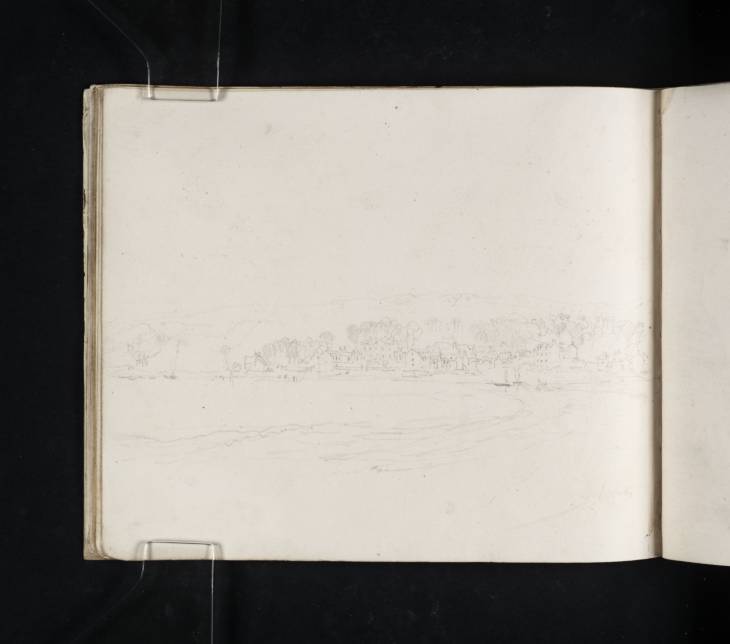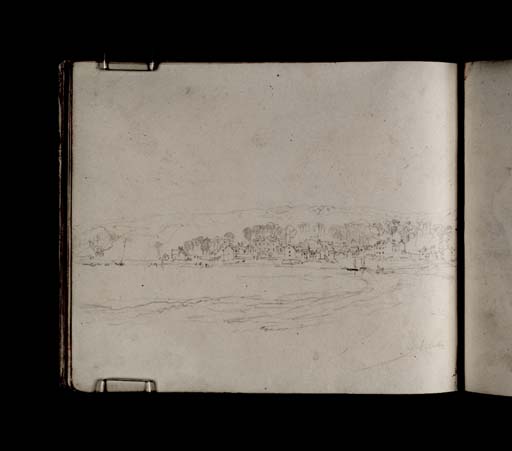Joseph Mallord William Turner Swanage from the North 1811
Image 1 of 2
Joseph Mallord William Turner,
Swanage from the North
1811
Joseph Mallord William Turner 1775–1851
Folio 15 Verso:
Swanage from the North 1811
D08822
Turner Bequest CXXIV 15
Turner Bequest CXXIV 15
Pencil on white wove paper, 170 x 209 mm
Blind-stamped with Turner Bequest monogram bottom centre
Inscribed by Turner in pencil ‘[?S Ives]’ bottom right
Stamped in black ‘CXXIV – 15’ bottom right on the recto (see discussion below)
Blind-stamped with Turner Bequest monogram bottom centre
Inscribed by Turner in pencil ‘[?S Ives]’ bottom right
Stamped in black ‘CXXIV – 15’ bottom right on the recto (see discussion below)
Accepted by the nation as part of the Turner Bequest 1856
References
1909
A.J. Finberg, A Complete Inventory of the Drawings of the Turner Bequest, London 1909, vol.I, p.354, CXXIV 15, as ‘Town on coast. ? Swanage’.
Swanage is viewed to the south from the beach, at about the point where Victoria Avenue now meets Shore Road, despite Turner’s apparent reference in his inscription to St Ives, which he drew in the Cornwall and Devon sketchbook on the same tour (see under Tate D41326; Turner Bequest CXXV a 47). In the background is the hill which runs down to Peveril Point beyond the edge of the composition to the left. There are views from and of the harbour, seen here in the distance, on folios 13 recto and 14 recto (D08820, D08821).
The building at the centre, with a pediment and a double staircase below its front door, was originally the Great House, built in about 1721 with wings added in about 1777. It became the Manor House Hotel in 1823, then the Royal Victoria Hotel after the future queen stayed in 1833, and subsequently the Royal Victoria Apartments.1 The façade is now half hidden from this angle by a block of flats on the quayside.2 The hillside behind it to the right has been built over, but the open slopes of the Downs on the left remain as parkland.
There are views approaching the town from the south on folios 11 recto and 12 recto (D08818, D08819). The foliation of the sketchbook suggests that Turner conducted a careful survey of likely motifs as he passed through the Swanage district from south to north, though none of the five views was taken further.3 The present drawing is the last before he turned west to continue his tour with a return visit to Corfe Castle (see folio 16 verso; D08824).
The current page was recorded by Finberg as if it were a recto (without the ‘a’ suffix by which he usually indicates a verso), but it is bound as the verso of the sheet and stamped on its blank recto. When Tate accession numbers were allocated to the sketchbook, the verso (i.e. the present drawing) was originally designated as D08823, but the number was cancelled as redundant.
Matthew Imms
February 2011
How to cite
Matthew Imms, ‘Swanage from the North 1811 by Joseph Mallord William Turner’, catalogue entry, February 2011, in David Blayney Brown (ed.), J.M.W. Turner: Sketchbooks, Drawings and Watercolours, Tate Research Publication, December 2012, https://www


